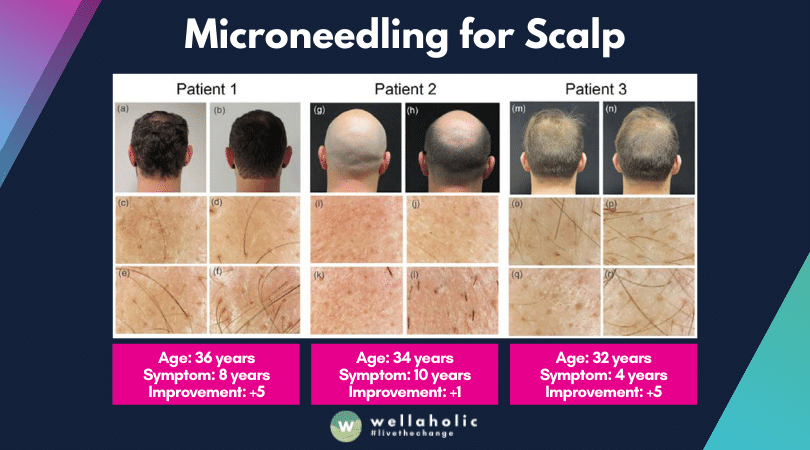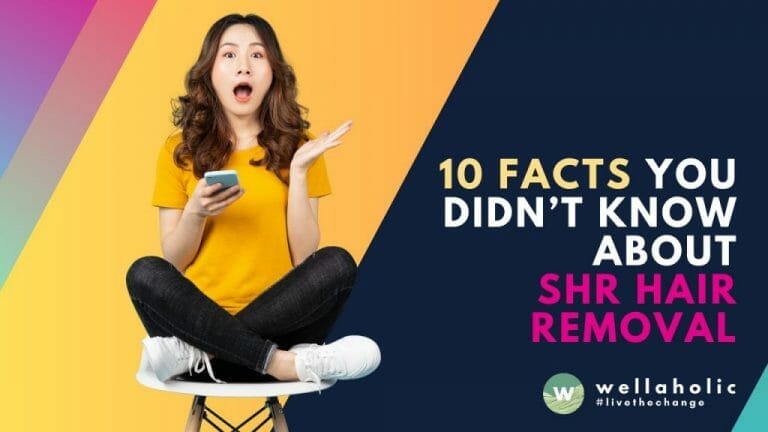
You’re Losing Your Hair. Here’s How to Fix It.
Table of Contents
- 0.1 TL:DR Summary
- 0.2 Introduction: You’re losing your hair. Here’s how to fix it.
- 0.3 The problem: Hair loss is a common problem, but it can be upsetting.
- 0.4 The cause: There are many possible causes of hair loss.
- 0.5 Aging Process can Cause Hair Loss
- 0.6 Alopecia Areata can Cause Hair Loss
- 0.7 Medication can cause hair loss
- 0.8 Medications to Treat Hair Loss
- 0.9 Hair transplant surgery to Treat Hair Loss
- 0.10 Customer Success Story with Scalp Microneedling (at Wellaholic)
- 0.11 Customer Testimonial for Benefits of Scalp Microneedling
- 0.12 Conclusion: Hair loss is a common problem, but it can be treated.
- 0.13 Frequently Asked Questions (FAQ)
- 0.14 Book Now Pay Later
- 0.15 Revolutionise Your Hair Regrowth Journey with Scalp RF Microneedling
- 1 You’re Losing Your Hair: Uncover Effective Techniques and Lifestyle Changes to Fix Hair Loss
TL:DR Summary
- Identify Hair Loss Causes: Consult a doctor for diagnosis and understand triggers.
- Choose Effective Treatments: Options include minoxidil, finasteride, microneedling, laser therapy, and hair transplant.
- Follow Treatment Guidelines: Adhere to prescribed dosage, frequency, and aftercare for best results.
- Supplement with Natural Remedies: Incorporate a balanced diet, vitamins, scalp massage, and gentle hair products.
- Embrace Hair Loss Confidently: Find suitable hairstyles, accessories, or consider shaving.
- Prevent Hair Loss: Use gentle hair care, eat healthily, and manage stress.

Introduction: You’re losing your hair. Here’s how to fix it.
In this article, I’m going to address a concern that’s close to the hearts of many: hair loss. If you’re one of the millions of men who start to lose their hair in their 20s, whether in Singapore or elsewhere in the world, you may be wondering how to stop the progression of hair loss.
The experience of losing your hair can be distressing and often impacts self-confidence. However, it’s crucial to understand that hair loss isn’t the end of the road. There are effective strategies and treatments available that can significantly improve this condition.
Expert Tips for Healthy Hair Growth
Drawing from my extensive conversations with Wellaholic customers, inputs from industry experts, and ongoing research, I will shed light on the most effective approaches to tackle hair loss.
This isn’t just about quick fixes, but rather understanding the root causes of hair loss and addressing them through a combination of lifestyle adjustments, treatment options, and preventative measures.
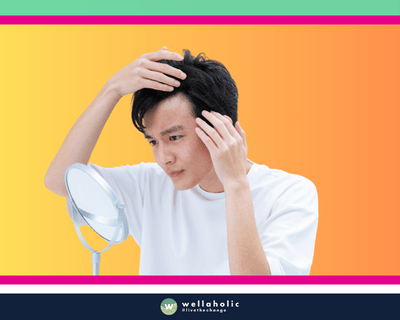
The problem: Hair loss is a common problem, but it can be upsetting.
In my years in the aesthetics industry, I’ve seen firsthand how hair loss can deeply affect individuals. It’s a prevalent issue, impacting not just one’s appearance but also their self-esteem. Often, clients express their frustration and emotional distress, making it clear that hair loss is more than just a physical problem.
Unveiling the Roots of Hair Loss & Treatment
Dealing with hair loss can be challenging, but it’s important to remember that it’s a treatable condition. Through my interactions, I’ve learned that early intervention and a tailored approach are key. Identifying the underlying cause is crucial, as it can range from genetic factors to lifestyle choices.
“Don’t let hair loss define you – take control and find a solution that works for you!”
The cause: There are many possible causes of hair loss.
Hair loss is a complex issue with a multitude of potential causes. It’s not a one-size-fits-all problem, and the cause can vary greatly from person to person. Factors such as genetics, hormonal changes, stress, and diet can all play a role in hair loss. Please see the table below for the main types of hair loss as well as their prevention and suggested treatment.
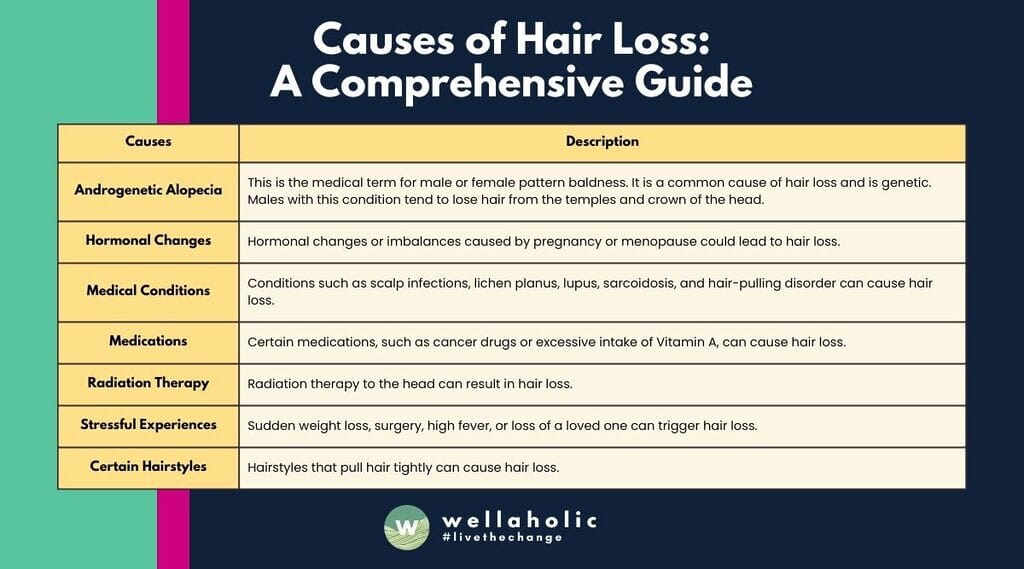

Aging Process can Cause Hair Loss
Hair loss is a common occurrence as we age. Our hair follicles start to diminish, leading to thinning hair and increased hair fall. This process is a natural part of aging and affects many people. As our hair follicles shrink, our hair becomes thinner and falls out more easily.
Silver Shine: Embracing Hair’s Natural Changes
As we grow older, our hair follicles produce less melanin, the pigment responsible for our hair color, leading to graying. Along with graying, thinning hair is also a common experience due to factors such as the aging of hair follicles, a decrease in scalp hair count, and a reduction in hair shaft diameter.
Despite these natural changes, there are steps we can take to maintain healthy, vibrant hair. Consuming a nutrient-rich diet with ample protein, vitamins A and C, iron, and omega-3 fatty acids can support hair health. Additionally, using gentle hair care products that don’t strip away natural oils can help keep our locks lustrous.
Alopecia areata, an autoimmune disorder that causes hair loss, is more common among Asians than in other ethnic groups. The incidence of alopecia areata in Asians is estimated to be around 0.2-0.3%, based on research by Wellaholic.
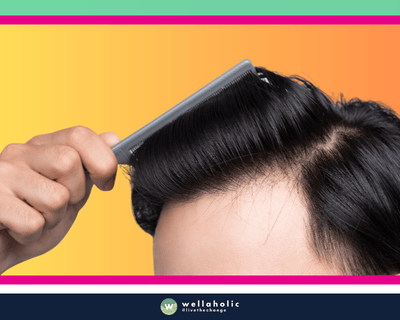
Alopecia Areata can Cause Hair Loss
At Wellaholic, I’ve seen how hair loss deeply affects individuals. Alopecia areata stands out as an autoimmune condition causing unpredictable, often patchy hair loss. It’s not just the scalp; hair loss can occur on the face and body. This disorder, where the immune system mistakenly targets hair follicles, can emerge at any age, often in children and young adults. Although it’s not contagious, the emotional impact is significant.
Trichotillomania & Psoriasis: Shedding Light on Hair Loss
Another condition I’ve encountered is trichotillomania, where individuals compulsively pull out their hair. It’s a psychological disorder that requires a sensitive approach. Scalp psoriasis, often leading to temporary hair loss, is another challenge. These conditions underscore the complexity of hair loss and the importance of holistic treatment approaches.
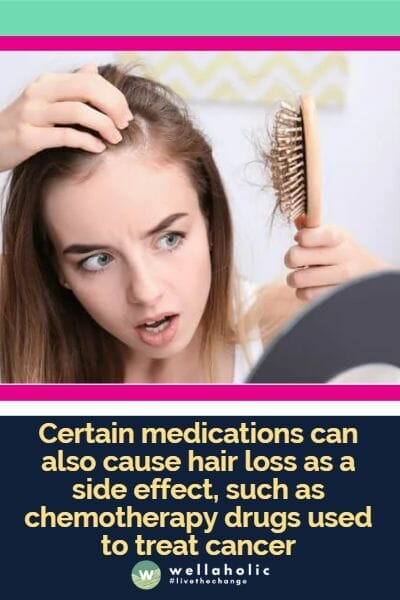
Medication can cause hair loss
In my time within the aesthetics industry, I’ve seen how certain medications, notably chemotherapy drugs, can lead to hair loss. This phenomenon, known as anagen effluvium, occurs when medications prematurely push hair follicles into a resting phase. It’s a temporary setback for many, as hair often regrows post-treatment.
Managing Hair Loss from Medication
However, it’s important to note that some drugs can cause permanent hair loss. If you’re experiencing this, I recommend discussing alternative medication options with your healthcare provider. It’s crucial to address these concerns proactively for your overall well-being.
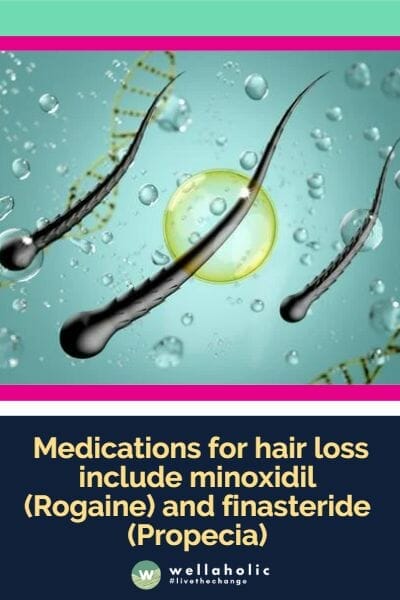
Medications to Treat Hair Loss
In my experience dealing with hair loss concerns, I’ve seen how medications like minoxidil and finasteride can offer hope. Minoxidil, a topical solution applied twice daily, seems to enhance scalp blood flow and stimulate hair growth. It’s a go-to for those seeking a non-invasive approach.
Fighting Hair Loss Progressively: The Finasteride Approach
Finasteride, on the other hand, is an oral medication taken daily. It targets DHT, a hormone implicated in hair loss, effectively slowing down the thinning process. It’s often recommended for more progressive hair loss cases.

Hair transplant surgery to Treat Hair Loss
Having consulted with many individuals considering hair transplant surgery, I’ve seen how this procedure can be a life-changing decision. Hair transplant, a method where hair follicles are moved from a donor site to a balding area, offers a solution to both male and female pattern baldness. It’s fascinating to see how this technique has evolved to provide more natural-looking results.
Outpatient Hair Transplant: Gradual Growth, Lasting Results
The process is usually outpatient, not requiring an overnight hospital stay. It spans several hours, but patience is key. Results typically emerge within 6-12 months, gradually restoring hair density. It’s a journey that requires both time and commitment.
When considering hair transplant surgery, it’s imperative to consult a board-certified plastic surgeon with specialized experience. This consultation is crucial for assessing your suitability and crafting a personalized treatment plan.
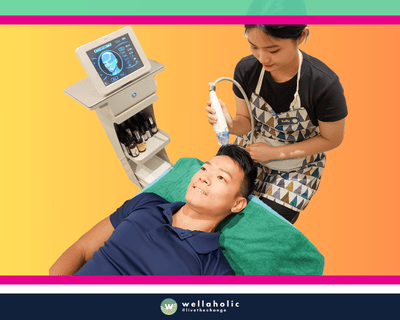
Microneedling for Scalp to Treat Hair Loss
As Microneedling for Scalp (by itself or combine with radiofrequency), I’ve seen microneedling evolve as an effective treatment for hair regrowth. Initially popular for skin concerns like wrinkles and scars, it’s now gaining attention in the hair loss domain. This method, by creating minute punctures, stimulates collagen production, crucial for hair health. It’s fascinating to see how this technique, rooted in skin rejuvenation, is finding new applications in hair restoration.
Microneedling’s Emerging Role in Hair Loss
The potential of microneedling for hair loss is an exciting development in aesthetic treatments. While it’s still under research, the early results are promising. It offers a beacon of hope for those seeking alternatives to conventional hair loss solutions. This innovative approach could open new doors in the realm of hair restoration.
See the table below for a breakdown of the benefits of Microneedling on Scalp for hair growth or hair regrowth.
| Benefits | Details |
|---|---|
| Increases blood circulation | – Microneedling creates tiny punctures on the scalp – Which stimulates blood flow to the hair follicles – This increased circulation can help to deliver more oxygen and nutrients to the hair follicles, promoting healthier hair growth. |
| Induces collagen production | – Microneedling can induce the production of collagen – Which is a protein that is essential for healthy hair growth – Collagen helps to strengthen hair follicles and improve the elasticity of the scalp, which can prevent hair breakage and hair loss. |
| Reduces inflammation | – Microneedling can reduce inflammation on the scalp – Which can be a contributing factor to hair loss – By reducing inflammation, microneedling can create a healthier environment for hair growth. |
| Enhances absorption of topical treatments | – Microneedling can enhance the absorption of topical treatments – Such as minoxidil or hair growth serums – The tiny punctures created by microneedling can help these treatments to penetrate deeper into the scalp, increasing their effectiveness. |
| Improves overall scalp health | – Microneedling can improve overall scalp health – By removing dead skin cells and unclogging hair follicles – This can create a healthier environment for hair growth and prevent conditions such as dandruff and scalp acne. |
Customer Success Story with Scalp Microneedling (at Wellaholic)
Meet our first customer, a gentleman who embarked on his hair regrowth journey with Wellaholic in March. Over the course of eight months, he experienced a transformation that was nothing short of remarkable.
In the before photos taken in March, you can clearly see the areas of thinning and hair loss. However, as the months passed and he continued with his HairGrow 3X treatments, the change became evident. The after photos taken in November show a significant increase in hair density and coverage.
This customer’s journey is a testament to the effectiveness of Wellaholic’s hair regrowth treatments. His commitment to the treatment plan and our expertise combined to create a success story that speaks volumes about the potential of our hair regrowth treatments. To read our customer success stories with before and after photos, click this link.

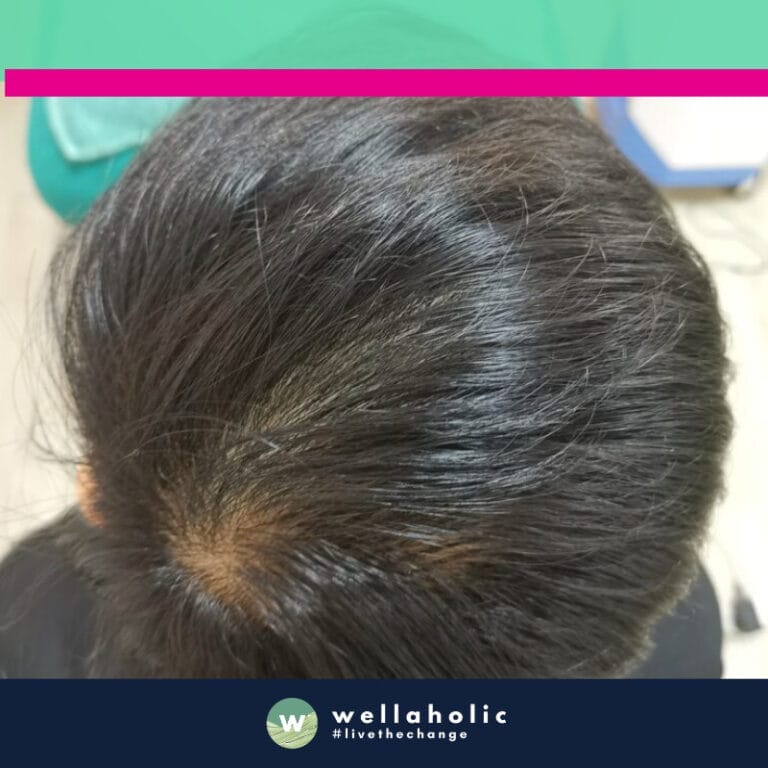

Customer Testimonial for Benefits of Scalp Microneedling
Vijay Ganesh sought treatment at Wellaholic for hair loss and thinning hair, choosing the Scalp RF Microneedling procedure. He was particularly impressed with his therapist, Khanie, who he described as experienced and hospitable, contributing to a wonderful microneedling session. Vijay was able to see results after several sessions of scalp microneedling treatments over the period of two to three months.
Read Actual Review by Customer
The therapist khanie is an experienced and hospitable person who did a wonderful job during the microneedling session. I recommend her if you are taking the treatment. (Source: Google Review)

Conclusion: Hair loss is a common problem, but it can be treated.
In conclusion, based on my extensive interactions with customers facing hair loss issues, and my in-depth research in the field of aesthetics, I’ve observed a few consistent strategies that can make a significant difference. First and foremost, it’s crucial to understand the root cause of the hair loss.
Whether it’s due to genetics, lifestyle, stress, or medical conditions, the underlying cause dictates the most effective treatment approach. Incorporating a balanced diet rich in essential nutrients, managing stress effectively, and maintaining a healthy scalp environment are fundamental steps.
Laser, PRP, Topicals: Unveiling Hair Loss Options
For more targeted solutions, treatments like low-level laser therapy, platelet-rich plasma injections, or even suitable topical treatments can offer substantial benefits. However, it’s important to approach these options with realistic expectations and under professional guidance. Hair loss is a complex issue and often requires a multi-faceted approach for optimal results.
Frequently Asked Questions (FAQ)
What percentage of men begin to experience hair loss in their 20s, and how does this compare to women?
Approximately 25% of men begin to experience hair loss by the age of 21. In contrast, women typically start to notice hair thinning in their 50s, although it can occur earlier.
Is there a significant difference in the effectiveness of hair loss treatments between men and women?
The effectiveness of hair loss treatments can vary between genders. Treatments like minoxidil and finasteride, for instance, have been found more effective in men, particularly in early stages of hair loss.
What is the success rate of microneedling treatments for hair regrowth?
Microneedling has shown promising results in hair regrowth, with studies indicating an improvement in hair density by up to 25% after one year of treatment.
How common is alopecia areata among Asians, and what are its primary treatment options?
Alopecia areata affects about 0.2-0.3% of Asians. Treatment options include topical or injectable corticosteroids, topical immunotherapy, and oral immunosuppressants.
What proportion of hair loss cases are due to medication side effects, and can this be reversed?
Medication-induced hair loss, particularly from chemotherapy drugs, is a common side effect. Most cases are temporary, with hair regrowth occurring post-treatment.
Are there any age-related patterns in hair loss, and how can they be managed?
Hair loss naturally occurs with aging, often starting with thinning in the 50s. Managing it includes a nutrient-rich diet, gentle hair care products, and possibly medical treatments like low-level laser therapy.
How do you help someone who is losing their hair?
To help someone experiencing hair loss, first encourage them to seek a professional diagnosis to understand the underlying cause. Offer support in exploring treatment options like minoxidil, finasteride, or laser therapy. Suggest lifestyle changes such as a balanced diet and stress management. Emotional support is also crucial in dealing with the psychological impact of hair loss.

Willie Chan, Founder
Willie Chan, a visionary leader and relentless pursuer of excellence, is the Founder and Managing Director of Wellaholic, a renowned aesthetic chain with 8 outlets across Singapore. With a strong belief in evidence-based, effective, and affordable aesthetic treatments, Willie ensures that customers receive the best care possible. His ENTJ Myer-Briggs personality drives him to set clear visions and pursue them without excuses. Willie holds a CIDESCO as well as Beauty Therapy & Salon Management from Brentwood College UK and has studied Operations Management at The Wharton School and Management at Ludwig-Maximilians-Universität München, equipping him with a solid foundation in the business of aesthetics.
Contact Willie at [email protected]
GET IN TOUCH
Book Now Pay Later

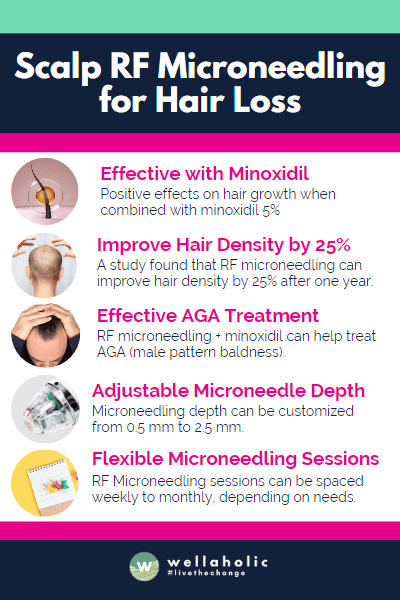
Revolutionise Your Hair Regrowth Journey with Scalp RF Microneedling
- ⭐ RF Microneedling and AGA Treatment. RF microneedling + minoxidil can help treat AGA (male pattern baldness).
- ⭐ Efficacy in Pattern Hair Loss. RF microneedling is effective for hair loss in both men and women.
- ⭐ Study Results on Hair Density Increase. A study found that RF microneedling can improve hair density by 25% after one year.
- ⭐ Adjustable Depth of Microneedling. Microneedling depth can be customized from 0.5 mm to 2.5 mm.
- ⭐ Flexible RF Microneedling Frequency. RF Microneedling sessions can be spaced from weekly to monthly, depending on your needs.
- ⭐ Award-Winning. Wellaholic’s treatments have been recognized by top beauty publications such as Daily Vanity, Beauty Insider, and Tropika Club Magazine.
- ⭐ Over 2000 Verified Customer Reviews. Wellaholic has over 30 industry awards and over 2000 positive reviews from customers, and >50% are repeat customers.
